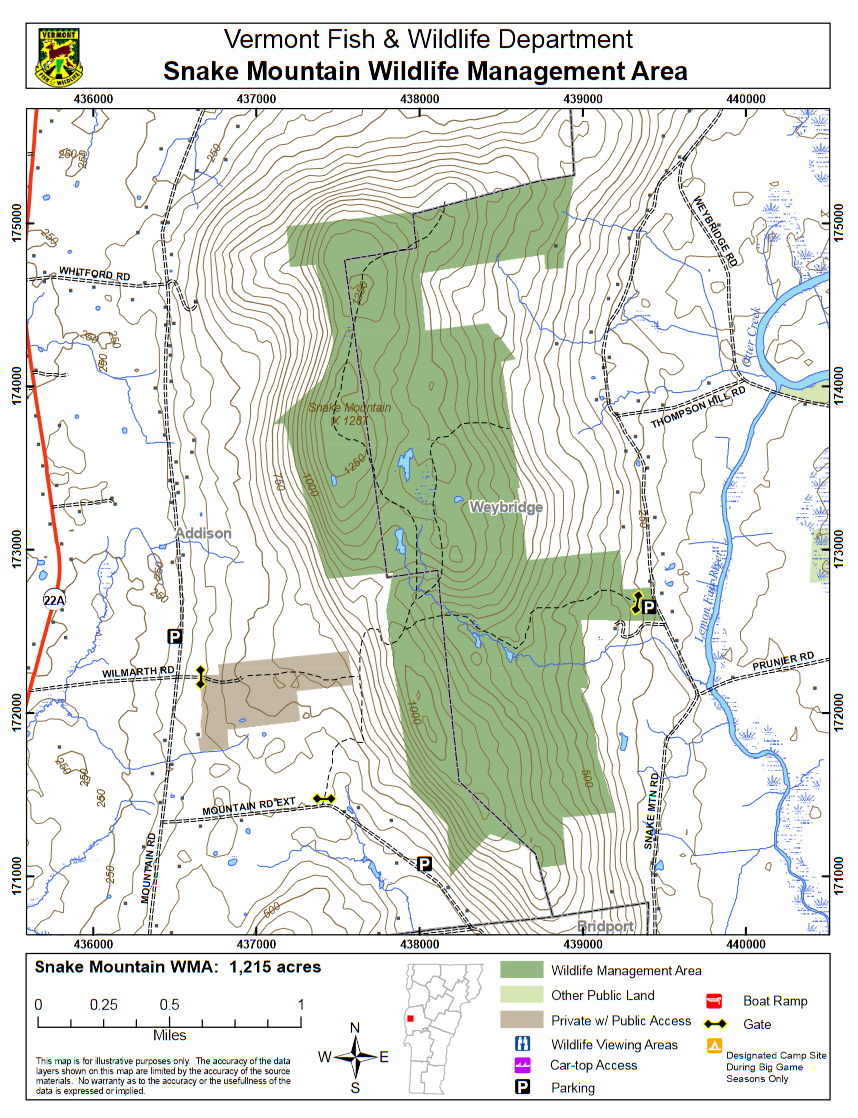Snake Mountain WMA
Tips for Birding
Birdwatching in Vermont, pp. 70-71.
Snake Mountain is a large island of forested habitat amongst the farmlands of Addison County. The woods at the base of the mountain produce blue-winged and golden-winged warblers. The summit offers good opportunities for hawk-watching in September as well as stunning views of the Champlain Valley.
The mountain summit can be accessed from either the east or west. From the east/Weybridge side, there is a parking area and trail on the west side of Snake Mountain Road between Prunier Road and Forest Road. From the west/Addison side, the parking area is on Mountain Road near the intersection of Wilmarth Road, with the trail located directly opposite Wilmarth Road. The cliffs visible from this parking area often host nesting peregrine falcons.
Spend time looking for hawks on the wing as you gaze at beautiful Lake Champlain and the Adirondack Mountains. Set out on a hiking trail from the eastern or western parking lot and meet up with a network of trails that crisscross the ridgeline and summit of the mountain. Birders come to Snake Mountain for the hawks, particularly during the fall migration, but they stay for the many woodland bird species.
Birds of Interest
There is excellent hawk watching from Snake Mountain during migration. Peregrine falcons have been nesting on the cliffs. Please obey posted signs to prevent disturbing them. All the woodland songbirds, woodpeckers, and owls that one might expect can be found. One notable songbird that has been known to breed here is the golden-winged warbler. Game birds present on the WMA are wild turkey and ruffed grouse.
About this Location
Snake Mountain Wildlife Management Area (WMA) is located in west-central Vermont in the towns of Addison and Weybridge. Its 1,215 acres span the upper slopes and summit of Snake Mountain. Access is from parking areas on Mountain Street near Wilmarth Road, Mountain Street Extension, and Snake Mountain Road south of Thompson Hill Road. There is a network of walking trails that crisscross the mountain. One popular day hike is to the summit from the Mountain Road parking lot. There are great views of the Lake Champlain Valley and the Adirondack Mountains from the summit. Some of the trails cross private land; please be respectful.
The WMA is owned by the State of Vermont and managed by the Vermont Fish and Wildlife Department. Timber rights are privately owned. Management goals for this area are to conserve wildlife habitat and provide public access.
Snake Mountain was once known as Grand View Mountain. There was a hotel on the summit aptly named “Grand View Hotel”, which was built around 1870 by Jonas N. Smith. It subsequently burned down, but part of the foundation remains. Smith also built an observation tower. The road going up to the hotel, once plied by stagecoaches bringing vacationers, is still a trail.
The Vermont Fish and Wildlife Department began to acquire land for Snake Mountain WMA in 1959 from the A Johnson Lumber Company, which has reserved timber rights. Vermont Fish & Wildlife Department funding, generated from hunting license sales, was used for most purchases. Recent acquisitions have used monies from the Vermont Housing and Conservation Board. There was also a private land donation.
Snake Mountain is a prominent feature in the Champlain Valley, jutting up from the surrounding level countryside, and reaching an elevation of 1,287 feet. As such, it is an island of upland forested habitat in the heavily farmed Champlain Valley. Most of the WMA is covered by northern hardwoods. However, several other forest communities result in a great diversity of plants and wildlife. These include a mesic red oak forest growing on deep, rich, well-drained soils, a dry oak-hickory hophornbeam forest on dryer soils, and a mesic maple-ash–hickory forest. There are also hemlock stands and eastern red-cedar in old pasture lower down. There are temperate calcareous cliffs and temperate acidic outcrop forests, both with many unusual plants, and a transition hardwood tallus wood. Hophornbeam is a dominant understory tree. Dwarf chinquapin oak and fragrant sumac are two unusual woody plants found in the WMA.
Herbaceous plants are diverse, including white trillium, dog’s-tooth violet, bloodroot, sweet cicely, beech-drops, large-flowered bellwort, bishop’s-cap, hepatica, Canada-violet, dwarf ginseng, small-flowered buttercup, Christmas fern, and rattlesnake fern. Back’s sedge, four-leaved milkweed, handsome sedge, needle-spine rose, hair honeysuckle, large yellow lady’s-slipper, podgrass, and squaw root. The State-endangered Douglas knotweed has also been found.
There is a very interesting wetland near the summit known as Cranberry Bog. It is about 33 feet deep and more than 9,500 years old. It began forming shortly after the retreat of the last glacier in Vermont. There is an acre of open bog mat, comprised mostly of sphagnum moss. Pitcher plants are abundant, and round-leaved sundew and tawny cotton grass are also present. Shrubs include bog rosemary, bog laurel, and sheep laurel. Dense leatherleaf rims the outer edge of the mat. The surrounding bog forest is dominated by black spruce with larch, red maple, and white pine. Highbush blueberry dominates the shrub layer in the bog forest; black alder and speckled alder grow as well. The entire wetland area is very fragile. Please minimize disturbance to it, and especially do not walk on the bog mat. And remember, no plants may be picked on public lands.
Notable Trails
The AllTrails website has a description and map of a hike at Snake Mountain.
Features
Restrooms on site
Wheelchair accessible trail
Entrance fee
Content from Snake Mountain Wildlife Management Area guide and map, Otter Creek Audubon Society, and Vermont’s Best Birding Hotspots by Vermont Agency of Natural Resources
Last updated December 3, 2023
